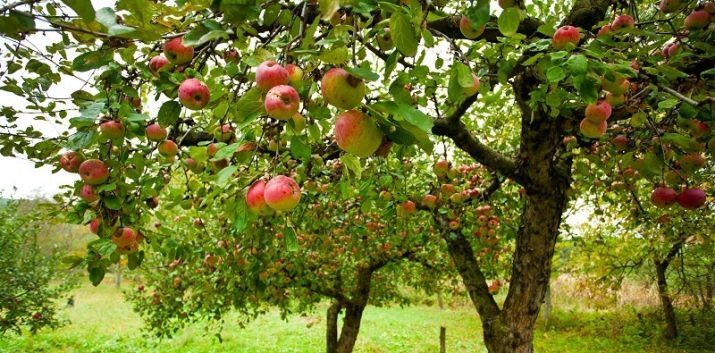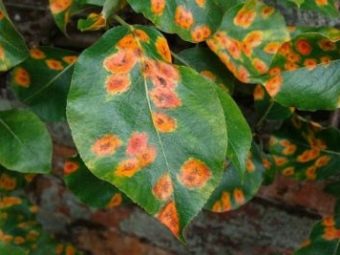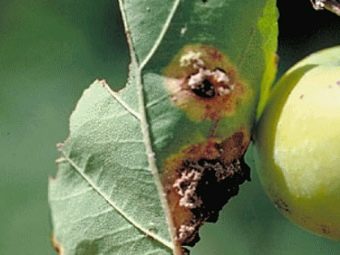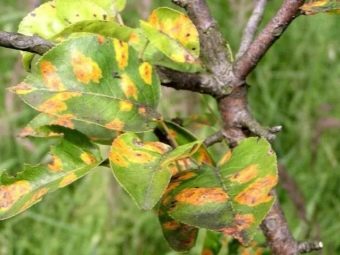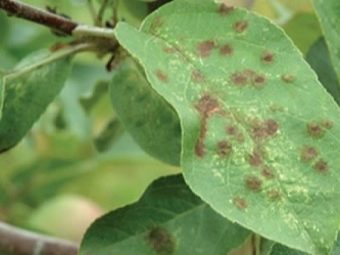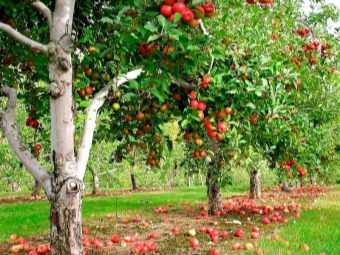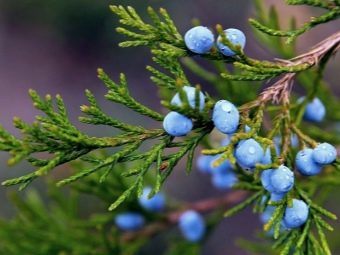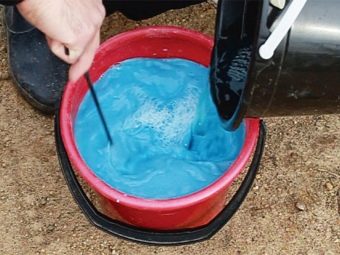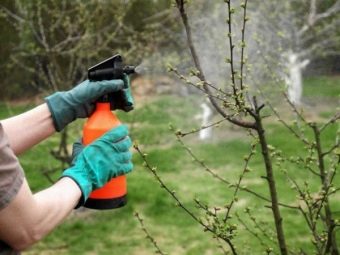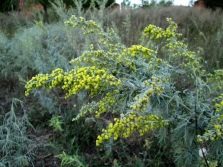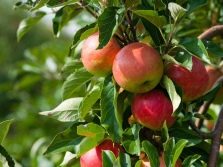How to deal with rust on the leaves of an apple tree?
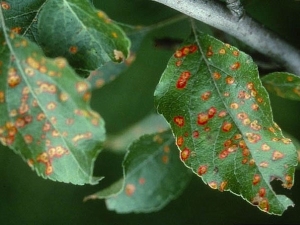
Apple tree is one of the most popular fruit trees, which can be found in almost any garden and vegetable garden in our country.This is due to simplicity and rather high crop yields. In addition, from the apples themselves, you can cook a lot of wonderful dishes and they are easy to save for the winter.
Most often, the apple tree does not require much effort from the gardener and grows well "by itself", but some may encounter small yellowish or black spots on the fruits and leaves. Most likely, it will be a disease called rust.
Description and symptoms of the disease
Rust is an infection of a tree by spores of a fungus that starts from the leaves and, if not properly cared for, can move to the branches and fruits of the tree. If you do not start the fight against fungal spores in the early stages, then the apple tree, which was covered with rust, will begin to wither and may simply die. Light spores of the fungus called Gymnosporangium tremelloides are carried by wind at distances from a few centimeters to tens of kilometers and are most dangerous for young shoots. Some of them die off under the influence of the disease, some become infertile, and the rest produce a harvest of diseased fruits. In addition, birds of a dispute may be birds or insects that fly from a sick plant to a healthy one.
Determining whether an apple tree is sick with rust is quite simple: only a visual inspection is necessary. At first small round specks of yellow-brown shade appear on the top of young greens. Over time, they grow in diameter and in quantity, until they begin to turn into small growths. Gradually growths are covered not only the leaves, but also the branches of the trees, and the first fruits are already growing with stains. Affected apples may be dry on the outside, but completely rotted inside.
Of course, if you notice the first signs of the disease in time and start fighting the fungus, the risk of getting a sick crop is minimal. To do this, regularly enough to pay attention to the young shoots of the tree and do not miss the moment of the appearance of the first spots.
However, rust is not the only reason for the appearance of round spots on the leaves of an apple tree. Sometimes this change in the green color indicates a shortage of certain substances. If the stains on the sheet appeared, but in color they do not resemble rusty metal, then it is necessary to carefully examine their color. This will help to understand what exactly should be fertilized apple. Spots can be different colors.
- Yellow spots. Such markings on the leaves of the tree along with the color change of the young shoots to dark brown indicates a lack of nitrogen in the soil.
- Bluish tint and a sharp cessation of the growth of young shoots signals a lack of phosphorus. If you do not make a special additive in the soil, the flowering and ripening of fruits may not occur.
- Brown spots on the drying leaves of the apple is a lack of potassium. Large leaves will begin to fall off, and new ones will not appear. Thus, a tree can fly around without waiting for autumn.
- Reddish tint lesions is an indicator of magnesium deficiency. Such a tree will bear fruit, but the apples will be very small and tasteless. If the spots are located only along the contour of the leaf, then instead of magnesium the plant requires copper.
- Not really spots, rather dark yellowish bloom appearing on the edges of apple leaves, evidence of a manganese deficiency.
The sooner the cause of the change in leaf color and the appearance of lesions on them is identified, the more effective the treatment will be. Red spots are much more dangerous for wood than a deficiency of any of the elements and minerals.
If it is impossible to distinguish a fungal disease from a normal nutrient deficiency in a timely manner and correctly, it is better to combine feeding the apple with its treatment from rust.
Causes of defeat
In most cases, the fungus falls on the plant from the beginning of spring to its end. The carrier of this disease is usually conifers and shrubs, especially juniper.A few decades ago, at risk were only the southern regions of the country, as only in these two types of plants could grow in the neighborhood. With the development of landscape design, more and more households appear with decorative areas on which a juniper bush has been planted. This led to the spread of fungal spores, which every year more and more actively attack apple trees.
The disease most quickly develops in conditions of high temperature and humidity. With frequent rains and early summer, the spores of the fungus feel most comfortable on the leaves of the apple tree. Since they are easily transferred even by the person himself on his clothes, skin, and hair, then after contact with a stand-alone infected apple trees, the gardener can infect other trees with his own hands. In dense apple thickets, the infection spreads at an alarming rate and can lead to the death of all apple trees without proper treatment. Spores, falling on the leaf, germinate in it and feed on the sap of the apple tree. They disrupt the process of photosynthesis and the nutrition of the plant itself; therefore, in a very short time (about 30–40 days), active suppression of the growth of fruits and shoots begins, the tree begins to crack and die.
How and what to treat?
If there are signs of infection of an apple with a fungus, it is necessary to start fighting with them as soon as possible. The treatment consists of several stages and includes not only a simple spraying, but also other necessary measures.
- Remove the cause of the disease. If a juniper grows on or near the plot, it is best to get rid of it. In almost 100% of cases, it is he who becomes the primary cause of the fungus. After the plant has been uprooted and destroyed, the vacated piece of land must be carefully dig. If the juniper grows at the neighbor's cottage and it is impossible to get rid of it, it is worth planting the nearest part of the garden with tall plants that can protect the fruitful trees from the fungus. They will block access to the apple and disputes will not be able to get on it.
- Remove affected areas. Those leaves, branches and fruits of the apple that are already affected by the fungus are almost impossible to cure. In addition, even if you do various spraying and processing, diseased shoots can infect healthy parts of the tree or neighboring apple trees. To avoid this, diseased branches will have to be cut or sawed off. The cut should be no higher than 10 cm from the last focus of the disease. This will preserve healthy fruit and reduce the risk of missing nascent rust spots.
The cut parts are best burned so as not to create a new threat. If there is no possibility of destruction by fire, then they should be taken away from the site and buried in the ground.
- To process by special means. After pruning, you can begin treatment with fungicidal (antifungal) drugs. There are several types of such solutions.
- Fungicides. Such funds are considered the strongest in the fight against fungal infections of apple trees. Processing with their help can give a positive result even if the tree has started to dry and die. One of the most popular fungicides that can be purchased at any flower or pet store is Topaz, Poliram and Strobe.
- Preparations with copper. These drugs can be used if the weather is not too hot, which is associated with the risk of burns from young shoots of apple trees. One of the most popular copper-containing agents is Bordeaux liquid. You can also purchase a product called "Blue Bordeaux" or "Kuproksat".
- Preparations with sulfur. Sulfur is also a popular rust control method on fertile plants. Especially effectively protects apple trees with direct spraying of diseased branches. Unfortunately, sulfur cannot be used during the flowering period, since sprayed plants will not be pollinated.Colloidal sulfur is one of the most inexpensive and popular drugs. It can also be ordered online or purchased in large shopping centers “Cumulus”, which is perfectly soluble in water and can be mixed with various fertilizers.
- Biological products. The treatment of diseased trees with such preparations not only relieves the spores of the fungus, but, unlike chemicals, is harmless to people, animals, insects and the plants themselves. Processed apples can be safely eaten even by children. The most effective means, according to customer reviews, are Planriz and Fitosporin-M. It is necessary to dilute the drug in a bucket of water in the amount indicated in the package instructions. Most often spraying is carried out three times with breaks of several days. It is necessary to spray the whole tree, starting from the topmost leaves and ending with the soil near the apple roots.
It is undesirable to eat the fruits of sprayed apple trees for several weeks after the end of treatment. Even after this time, it is worth washing the fruit thoroughly under running water before you eat or cook it.
Prevention
Like any disease, rust is better to prevent than to cure. First of all it is necessary to solve the issue with a decorative juniper. It is necessary to prioritize between a beautiful landscape and rich harvest. Those who are more important to save the coniferous shrub can simply cut down the apple trees and plant non-fruitful trees in their place. If a juniper planted a neighbor, then cut it out on a foreign site does not work. In order to protect your garden from spores of fungus that fall on the site from behind the fence, you can plant a space near the fence with a wormwood. The bitter plant perfectly frightens away the rust fungus and protects the host crop.
In order not to deal with overgrown disputes, It is best to carry out preventive spraying of the apple before it is infected. This should be done in the spring after establishing a positive temperature. And it is also possible to spray anti-microbial apples and other fruit trees. This is done three times per season. The first spraying is done before the appearance of young foliage, the second - before the flowering of the tree, and the third - after flowering.
Regular inspection of apple trees for the appearance of various spots and discoloration of the leaves should become a habit of a good gardener, which will notice the disease in the early stages and cure it without loss of yield. In addition, timely preventive measures will prevent the spore from getting on the plant and keep the apple tree throughout the spring-summer season.
On how to deal with rust on the leaves of an apple tree, see the following video.

